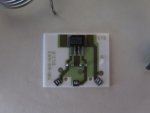Hi guys,
A weird thing happened this afternoon. The 206 has been running pretty much perfectly since I got it.
I parked at the station today, and on the way home it firstly didn't indicate left (no flashing) then was fine, but then started cutting out off idle as soon as I moved the throttle. I revved it and got home but each time I came to a slow it would almost cut out. Now a couple of hours later, it starts fine but wont take throttle at all without stalling.
I'm being a bit slack here and hoping this is indicative of something, because my son's in hospital with a strange disease they're trying to diagnose and I haven't time to check anything yet as we've been a bit preoccupied. I haven't had time to check all connectors on the loom although I did have a cursory look and fiddle.
There are no engine/ecu lights illuminated on the dash. I did find the battery negative was loose and tightened it. I also played with the battery cover yesterday while I was topping up the brake fluid (just saying because I may have bumped the lead - could this cause an issue?). However it ran fine yesterday and this morning.
Any ideas?
Cheers
Stuey
A weird thing happened this afternoon. The 206 has been running pretty much perfectly since I got it.
I parked at the station today, and on the way home it firstly didn't indicate left (no flashing) then was fine, but then started cutting out off idle as soon as I moved the throttle. I revved it and got home but each time I came to a slow it would almost cut out. Now a couple of hours later, it starts fine but wont take throttle at all without stalling.
I'm being a bit slack here and hoping this is indicative of something, because my son's in hospital with a strange disease they're trying to diagnose and I haven't time to check anything yet as we've been a bit preoccupied. I haven't had time to check all connectors on the loom although I did have a cursory look and fiddle.
There are no engine/ecu lights illuminated on the dash. I did find the battery negative was loose and tightened it. I also played with the battery cover yesterday while I was topping up the brake fluid (just saying because I may have bumped the lead - could this cause an issue?). However it ran fine yesterday and this morning.
Any ideas?
Cheers
Stuey


